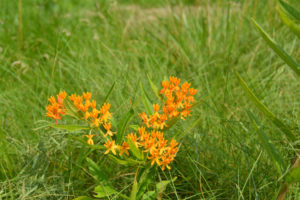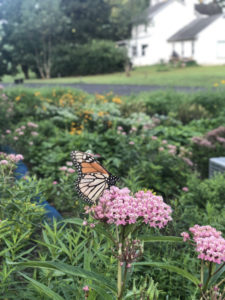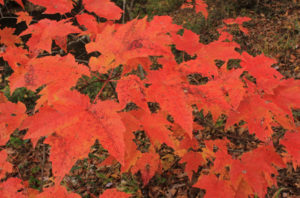Rain Gardens—Digging Deeper
Not just another pretty garden bed, rain gardens enhance your property.

Rain gardens are popping up everywhere. You’ll find them on college campuses and office parks, in mall parking lots, along city streets and multi-use trails. They’ve grown in popularity over the last several years in response to the many problems stormwater causes in the landscape.
When it rains—especially heavy rains—we often see flooding, erosion and pollution from stormwater runoff. Just the first inch of rain during a storm does the most harm.
The good news is local use of rain gardens (even on your own property!) can help reduce flooding, erosion and pollution over a broad region.
Here’s how.
The Benefits of a Rain Garden
 First, what is a rain garden? It’s not just another garden bed, and it doesn’t need to be limited to perennial wildflowers and grasses. Shrubs and trees can also be used in rain gardens to achieve increased absorption, retention and beauty.
First, what is a rain garden? It’s not just another garden bed, and it doesn’t need to be limited to perennial wildflowers and grasses. Shrubs and trees can also be used in rain gardens to achieve increased absorption, retention and beauty.
A rain garden on your property provides many benefits, including:
• Intercepting water and provide habitat for birds and wildlife,
• Reducing stormwater runoff by 30% compared to a traditional turf lawn,
• Adding natural beauty when well designed.
Planning Your Rain Garden
When planning a rain garden, one of the first things you need to know is the infiltration rate of your soil, or how quickly water drains through it. This rate determines whether your soils can support a rain garden.
You can determine the infiltration rate yourself in four steps:
1. Dig a hole one foot deep, being careful not to disturb the sides or compact the soil in the hole.
2. Pour 444 mL (about 15 ounces, or 1 inch) of water into the hole and let it drain completely.
3. Fill the hole with water again. Place a ruler in the center, flush with the bottom to measure the depth later.
4. Wait 15 minutes and measure the water depth again. Then multiply the depth of the water in inches by 4 to determine the infiltration rate.
Rates of .5 to 8 inches in an hour are sufficient for rain gardens.
Size: Next, consider the location and size of your rain garden. The Philadelphia Water Department recommends creating a rain garden that equals 20–30% of your yard’s impervious surfaces (roof, driveways, patios, walkways and other surfaces that don’t allow rain to be absorbed).
Location: For location, your rain garden should be a minimum of ten feet away from the foundation of your house and your property line and be placed in the lowest spot of the yard. The area for the rain garden should have a 1% slope away from your house to allow proper drainage.
The rain garden will need either an outflow or a drain to provide for water from large storms and to prevent flooding. Make sure that the direction of the discharged water is away from your house and your neighbor’s property!
Digging: When digging the rain garden, if your soil is rich with organic matter, two to three inches of depth will be sufficient. If it’s not and you need to amend the soil, dig down five to six inches and add compost.
Taper the edges of the rain garden toward the center to prevent erosion.
Final advice: Always check with PA 1-Call before you dig, to make sure you’re clear of unseen obstacles underground.
Selecting Plants
 Now for the exciting part: deciding what to plant. The funny thing about rain gardens is that most of the time, they’re dry! While you might think wetland plants would be best, floodplain plants that can handle periods of heavy rains and drought are actually ideal.
Now for the exciting part: deciding what to plant. The funny thing about rain gardens is that most of the time, they’re dry! While you might think wetland plants would be best, floodplain plants that can handle periods of heavy rains and drought are actually ideal.
Basically, a rain garden functions like a small floodplain where water can stop, slow down, infiltrate into the soil and be absorbed by plant roots.
So, what plants are common to floodplains?
Trees: If the size of your rain garden is large enough to allow for a tree, that can be a fantastic focal point. In our region, you have a variety of native trees to choose from:
• Canopy trees, such as red and silver maples, sycamore, river birch, pin oak, swamp white oak, and black gum.
• Understory trees, such as black willow and sweet-bay magnolia
Bald cypress is a great southern species, too. As our area continues to warm up, using more southerly species may be a way to increase the longterm vitality of your landscape.
 Shrubs: Choosing the shrub layer of floodplain plants offers a rich palette of choices of plants, and once established, shrubs require little maintenance. Highbush blueberry, red chokeberry and black chokeberry look lovely and provide edible fruit. Buttonbush, arrowwood, winterberry holly, ninebark, meadowsweet, sweet pepperbush, possumhaw, red twig and silky dogwoods offer a variety of color, texture and seasonal interest to round out a rain garden.
Shrubs: Choosing the shrub layer of floodplain plants offers a rich palette of choices of plants, and once established, shrubs require little maintenance. Highbush blueberry, red chokeberry and black chokeberry look lovely and provide edible fruit. Buttonbush, arrowwood, winterberry holly, ninebark, meadowsweet, sweet pepperbush, possumhaw, red twig and silky dogwoods offer a variety of color, texture and seasonal interest to round out a rain garden.
Design: Thinking of your rain garden as a habitat with niches to fill can help guide your design and plant selection. Plan on a variety of heights and moisture tolerances between the center and edges. Plant low growing cool season bunch grasses for early season cover, wildflowers for summer color, and shrubs for height and fruit.
Whether you plant trees, shrubs, wildflowers or grasses, rain gardens can provide beauty, functionality and habitat for wildlife for your landscape. Dig deeper and decide for yourself what type of rain garden fits your landscape and start helping your community by reducing stormwater runoff at home. Many small actions can really make a big difference.
See a Rain Garden
 The Willistown Conservation Trust’s Rushton Conservation Center features a rain garden designed by Jonathan Alderson Landscape Architects. It includes sweetbay magnolia and sweet pepperbush, along with a variety of wildflowers and grasses that were planted as plugs and seed. Swamp milkweed, butterfly weed, purple coneflower, bee balm, beardtongue, mountain mint and asters fill the basin with seasonal color and attract pollinators all summer long.
The Willistown Conservation Trust’s Rushton Conservation Center features a rain garden designed by Jonathan Alderson Landscape Architects. It includes sweetbay magnolia and sweet pepperbush, along with a variety of wildflowers and grasses that were planted as plugs and seed. Swamp milkweed, butterfly weed, purple coneflower, bee balm, beardtongue, mountain mint and asters fill the basin with seasonal color and attract pollinators all summer long.
The circular driveway around the rain garden is pitched inwards to drain runoff during storms. A surface drain in the rain garden directs overflow to a nearby underground stormwater basin.
Willistown Conservation Trust’s conserved land includes three nature preserves open to the public year round, free of charge. These preserves have scenic walking trails and abundant wildlife. Visit WCTrust.org/land/preserves for information, maps and directions and to learn more about their work.
Our Favorite Resources
- Arrowwood Landscape Design
- B&D Builders
- Ball & Ball
- Berk Hathaway Country Prop
- Berk Hathaway Holly Gross
- Berk Hathaway Missy Schwartz
- Cullen Construction
- Dayton Lock
- Dewson Construction
- E.C. Trethewey
- Homestead Structures
- Keystone Gun-Krete
- King Construction
- Main Street Cabinet Co.
- McComsey Builders
- Monument/Sotheby’s Int’l
- Mostardi Nursery
- Mountaintop Construction
- MR Roofing
- NV Homes
- Precise Buildings, LLC
- Rittenhouse Builders
- Sheller Energy
- Shreiner Tree Care
- Stable Hollow Construction
- Warren Claytor Architects
- Wedgewood Gardens
- White Horse Construction
